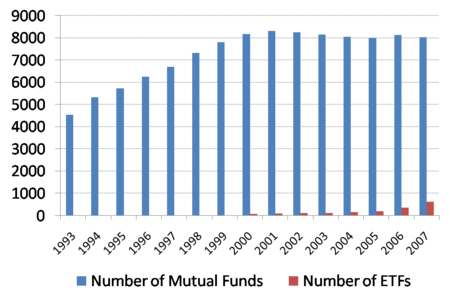Making Sense of OpenEnd Funds of ETFs
Post on: 19 Октябрь, 2015 No Comment

An effort of a couple of years ago to form open-end funds of ETFs has yet to gain more than a little momentum, but TheStreet.com Ratings is monitoring the phenomenon’s potential.
The Ratings database was parsed for open-end mutual funds that invest — with the possible exception of cash and equivalents — entirely in ETFs. It produced the accompanying table of only nine asset allocation funds.
No such funds could be found that were introduced more recently than a year and a half ago, though some ETFs of ETFs were recently launched. or you could try to build your own.
Combined with the fact that the aggregate net assets of the group total only $251.6 million — a small fraction of 1% of all fund assets — it seems to indicate that the concept of open-end funds of ETFs remains an idea whose time has not yet arrived.
Six of the funds on the list debuted more than two years ago, with the most recent arrivals being the Seligman Target ETF Fund 2035 (STZAX ) and the Seligman Target ETF Fund 2045 (STQAX ). which checked into the world in October of 2006.
Each of the funds in the table is available in multiple classes of shares. The Seligman funds are each available in five classes, including institutional and retirement versions. The Wilmington ETF Allocation A (WETFX ) is kept company by an institutional class and the trio of Federated funds of ETFs come in three varieties each.
Buying these funds, as opposed to directly owning the ETFs, seems difficult to justify. Sales charges and expenses would limit the potential for these funds for most investors, compared with traditional index funds or even direct purchases of ETFs. Possible exceptions would be those with small initial investments who would want to make modest periodic additions to their holdings.
All the funds in the table are available for a minimum investment as low as $1,000, except for the Federated offerings, which require minimum initial outlays of at least $1,500.
Some investors interested in diversification beyond what they might achieve with low-expense no-load index funds conceivably might find reason to consider a fund of ETFs. In these cases, the sales charges on the funds would likely be less than brokerage commissions on direct purchases of ETF shares. But the expense ratios of the funds of ETFs — all higher than the levies on the ETFs in their portfolios — would eat into the total values of investor holdings over time.

Because ETFs have yet to penetrate 401(k) retirement plans to any significant extent, open-end funds of ETFs might have appeal for investors in these plans. However, most retirement plans offer traditional index funds with lower expense ratios than the funds of ETFs.
The logic behind the seven target funds on the list is that risks can be tolerated early in a long-term investment program, but that capital preservation should be stressed as the plan approached maturity.
For example, riskier investments with potential for above-average returns make up close to half the Seligman Target ETF Fund 2045. The iShares Russell Mid Cap Index ETF (IWR ) makes up 24.8% of its portfolio, with the iShares Russell 2000 Index ETF (IWM ) adding 24.6% to its holdings. The more conservative SPDR Trust (SPY ) makes up only 14.75% of its portfolio.
The Seligman Target ETF Fund 2015 FTOAX, which is closer to its target date, holds only 20.3% of its portfolio in the iShares Russell Mid Cap Index ETF and 11.3% in the iShares Russell 2000 Index ETF. But its position in the steadier SPDR Trust is 22.1%.
OPEN-END FUNDS USING ETFs FOR ALLOCATING ASSETS














